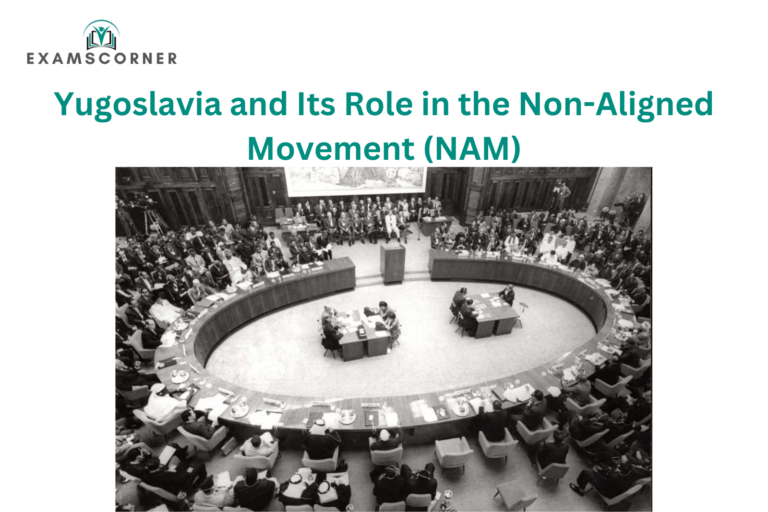The Socialist Federal Republic of Yugoslavia, under the leadership of Josip Broz Tito, played a significant role in the formation and development of the Non-Aligned Movement (NAM). The country’s capital, Belgrade, hosted the first NAM summit in 1961, making it an essential player in the movement’s early years. This article explores the relationship between Yugoslavia and NAM, shedding light on its policies and influence during the Cold War era.
Yugoslavia’s Role in the Foundation of NAM
Yugoslavia’s path to the Non-Aligned Movement was shaped by its unique historical and political circumstances. The country gained liberation from World War II largely through the efforts of its own resistance movements, with minimal assistance from the Soviet Red Army or Western allies. This independent path to freedom gave Yugoslavia’s communist leaders a sense of political legitimacy among its various ethnic groups and allowed them to pursue a more autonomous foreign policy.
Yugoslavia’s communist government, led by Josip Broz Tito, saw itself as an equal partner in the global arena, rather than a subordinate state within the Soviet sphere of influence. This stance quickly led to tensions with Joseph Stalin, the leader of the Soviet Union, and ultimately, the 1948 Tito-Stalin split. This event solidified Yugoslavia’s decision to move away from the Eastern Bloc, prompting a reevaluation of its foreign alliances.
Initially, Yugoslavia aligned itself with the Western Bloc, signing the 1953 Balkan Pact with NATO members such as Greece and Turkey. However, the death of Stalin in 1953 and the subsequent Soviet invasion of Hungary in 1956 worsened Yugoslavia’s relations with both the Eastern and Western Blocs. Recognizing the need for a new path, Yugoslavia began forging connections with the newly independent former colonies in Africa and Asia, which would later form the core of the Non-Aligned Movement.
Yugoslavia’s Involvement in the Creation of NAM
During the 1950 United Nations General Assembly, Yugoslavia’s Foreign Minister, Edvard Kardelj, made a landmark statement, asserting that “Yugoslavia cannot accept mankind choosing to be dominated by one power or another.” In December 1954, Tito met with Indian Prime Minister Jawaharlal Nehru in Delhi, where they signed a joint agreement to pursue a policy of collective peace through non-alignment. This event marked the beginning of Yugoslavia’s commitment to the Non-Aligned Movement, alongside countries such as India and Egypt.
One distinctive feature of Yugoslavia’s approach to non-alignment was its balancing act between both the capitalist West and communist East. While Yugoslavia’s government was communist, its economy was closely linked to Western Europe, allowing it to navigate the Cold War’s tensions more effectively.
Yugoslavia’s NAM Policies
Yugoslavia was an influential voice within the Non-Aligned Movement, advocating for a more neutral and independent stance for all member nations. The country pursued policies that kept both Cold War blocs at arm’s length, often questioning the closer ties some NAM members had with either the Soviet Union or the United States. This was particularly evident in the cases of Angola and Vietnam, which were perceived to be more aligned with Soviet interests due to Lenin’s thesis on the natural identity of interests between Soviet socialism and the independence struggles in Africa and Asia.
Together with India, Yugoslavia worked to amend a draft declaration at the 1979 Havana NAM Conference, which they saw as too pro-Soviet. By 1989, a more balanced and equidistant declaration was adopted, reflecting Yugoslavia’s influence on the movement’s policy.
Yugoslavia’s policies also emphasized cooperation with other neutral countries, such as Finland, to mediate tensions between the Cold War blocs. Tito’s international visits often highlighted the importance of the Mediterranean becoming a zone of peace, reinforcing Yugoslavia’s role as a bridge between East and West.
Despite its strong stance on non-alignment, Yugoslavia faced criticism from some quarters for being too Eurocentric in its approach, particularly in regard to decolonization. While it supported decolonization efforts globally, Yugoslavia’s more measured support led it to join the Special Committee on Decolonization, urging the United Kingdom to grant independence to its remaining colonies.
Yugoslavia After the Cold War: The Decline of NAM Influence
The end of the Cold War and the disintegration of Yugoslavia had a profound impact on its involvement in the Non-Aligned Movement. The Yugoslav Wars of the early 1990s led to the breakup of the country into separate republics. Following the dissolution of Yugoslavia, the remaining states of Serbia and Montenegro continued to claim membership in NAM, but their membership was suspended in 1992 due to the ongoing conflict.
Today, the six former Yugoslav republics — Bosnia and Herzegovina, Croatia, Montenegro, Serbia, North Macedonia, and Slovenia — are all observer states within NAM, but none are full members. As of 2020, Croatia, North Macedonia, and Slovenia are NATO members, while Serbia maintains a neutral stance on military matters. Additionally, all former Yugoslav republics are either members of or striving for membership in the European Union.
Conclusion
Yugoslavia’s role in the Non-Aligned Movement was pivotal during the Cold War, as it helped establish and solidify the movement’s principles of independence, neutrality, and collective peace. Under Josip Broz Tito’s leadership, Yugoslavia navigated the complexities of global politics by maintaining equidistant relations with both the Soviet Union and the Western Bloc. While the country’s breakup and subsequent conflicts disrupted its involvement in NAM, its legacy as a founding member continues to influence the movement today.



